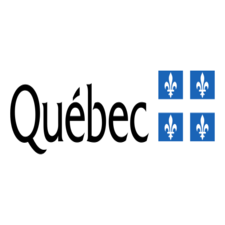Nunavik
Type of resources
Available actions
Topics
Keywords
Contact for the resource
Provided by
Formats
Representation types
Update frequencies
status
-

**Permafrost** is any soil or rock whose temperature has remained below 0°C for years. In the extreme north of Quebec, it is omnipresent and very thick. At its boreal margin, further south, it appears in the landscape in the form of isolated thin plates, whose thickness is generally less than 10 m. Permafrost contains ice in various forms, whose origin is closely linked to the sedimentary characteristics and drainage conditions of the land. The mapping of permafrost conditions for Nunavik (territory located north of the 55th parallel), carried out by the Center for Nordic Studies at Laval University, was done by applying a simple model called TTOP (Temperature at the Top Of Permafrost) for the period from 2000 to 2016. The results of the model are presented in the form of a raster file that illustrates the distribution of continuous, discontinuous, and sporadic permafrost, as well as isolated islands. Under the effect of global warming or poorly adapted human activities, permafrost heats up or even thaws, which leads to settlements and ground movements affecting ecosystems as well as infrastructures. Thus, the susceptibility of the territory to thermokarstic subsidence was evaluated for the same territory taking into account the ice content and the temperature at the top of the permafrost. A matrix file (raster) of the susceptibility of the territory to ground subsidence associated with permafrost thaw presents three susceptibility classes (high, moderate, and low) as well as areas generally without permafrost. **This third party metadata element was translated using an automated translation tool (Amazon Translate).**
-

The Inuit Regions, also known as the Inuit Nunangat, dataset contains the geographical boundaries of the 4 Inuit Regions in Canada: Inuvialuit, Nunavut, Nunavik and Nunatsiavut. The boundaries, land only, have been drawn as per information defined in each land claim agreement. The marine boundaries of the 4 Inuit Regions will soon be available. The Inuit Regions (Inuit Nunangat) geographical boundaries are approximate and should be used for illustration purposes only. This dataset is Crown-Indigenous Relations and Northern Affairs Canada (CIRNAC) and Indigenous Services Canada (ISC) official source for Inuit regions on maps.
-
In 2022, the federal government launched the second phase of the Oceans Protection Plan, a vast interdepartmental program designed to enhance marine safety in Canada by improving our ability to prevent and respond to marine incidents. For the Canadian Wildlife Service (CWS) of Environment and Climate Change Canada (ECCC), this means filling gaps in our knowledge of marine and coastal bird species. In order to identify these gaps for the province of Quebec, we carried out a prioritization exercise in 2022 and concluded that major efforts needed to be made in the Nunavik marine region, since data were lacking in several sectors and for several species. Understanding the vulnerability of wildlife species over time and space will help us, among other things, to assess risks and act quickly and appropriately in the event of incidents affecting the marine environment, such as an oil spill or shipwreck. Another important objective of the Oceans Protection Plan is to implement sustainable partnerships with the Inuit in order to share our respective knowledge of migratory birds, develop joint projects and support Inuit-led marine bird projects. It is in this context that ground surveys of marine bird nests on the islands of Nunavik are being carried out by the CWS, in collaboration with Nunavimmiut. The main objective of these surveys is to update available data on the abundance and distribution of nesting seabirds in this area, particularly Common Eiders (Somateria mollissima). On each island visited, a team follows transects distributed from one end to the other and across the entire width of the island, in order to obtain complete and systematic coverage of the island and to count all the nests present. The spacing between transects can vary according to the size of the island, its topography and the density of nests present. This database provides access to the survey results and shows, for each island surveyed, the number of nests of each species present. In the case of the Black Guillemot (Cepphus grylle), since nests are very difficult to find, it is rather the number of adults present around the island that is reported. Finally, in some cases, notably for gulls (Larus spp.), if no nests were found, but adults were observed on or around the island, then a number of adult individuals was reported.
 Arctic SDI catalogue
Arctic SDI catalogue